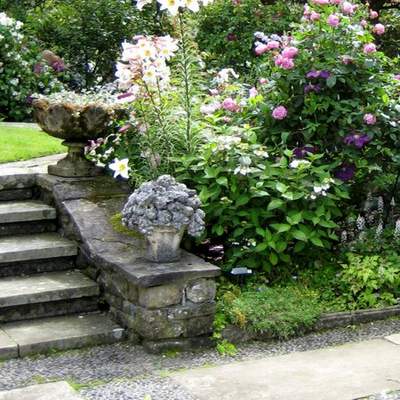Home › Patio ideas
Patio Ideas
How To Design A Patio
Patios have got to be one of the best and easiest ways to extend your living space.

They effectively blur the boundaries between house and garden allowing you to make the most of both by creating a 'garden room'.
In cooler climates they give you the opportunity to easily step outdoors to enjoy the available sunshine, whilst in warmer climates they can provide a refreshingly cool and shady refuge from the heat of the sun.
They can provide an area for outdoor dining and entertaining, or a safe place for children to play.
If you enjoy container gardening a patio provides the perfect setting for your pots and planters.
There are innumerable advantages to having a patio, but there are also pitfalls and it is possible to invest a lot of time and money in creating a patio that just doesn't work for you and your family.
The key to success lies in the planning stage...
Patio Ideas: Identify What You Want
This is the crucial first step and it is important to spend time deciding how you will use your patio and which features you would like to incorporate into your patio design.
For example, if you like to entertain and dine outdoors, you will need a patio that is large enough to accommodate your guests, dining table and any other furniture you will need.
To derive the maximum amount of use and enjoyment from your patio, you will almost certainly want to invest in an outdoor patio lighting system, so you may need to install an electricity supply in the early stages.
If you have young children a patio can provide them with a safe play area close to the house and under your supervision. In this case you will need to create a design with child-friendly surfacing and features, and to avoid plants that are toxic, irritating to the skin, or thorny.
If you have restricted mobility think about installing built-in raised beds that can be tended from a sitting position, and ensure that you choose a smooth, but non-slip, surface for the patio as a whole. Also consider ease of access from house to patio and from the patio to the rest of the garden.
It is also a good idea, at this stage, to give some consideration to the type of patio flooring or surface you would like as the material you choose will have a bearing on costs and should be suitable for both your needs and your site. You can find more information about the different types, including their advantages and disadvantages, at choosing the best patio flooring.
Patio Ideas: Create a Wish List
Once you have identified your needs it will be relatively easy to create a wish list comprising essential items, such as an electricity supply and screening for privacy, and desirable items, such as a water feature or a sandpit for the children.
Organise your wish list in order of priority with the essential items at the top, and the non-essential, but desirable items at the bottom. This list will form the basis of your overall design so keep it handy.
Patio Ideas: Assess the Site
Once you have your wish list spend some time taking stock of the site and assessing its suitability for what you have in mind. It is worth spending some time doing this, so go out into the garden at different times and over the course of a few days to think about how the items on your wish list will work in practice.
Useability
It is a good idea to experiment by actually trying out the activities you are envisaging.
Take a table and chairs into the garden and see what it is like to actually enjoy a meal in the location you have chosen. Do you feel exposed and overlooked?
Or is the site you have chosen subject to unpleasant draughts or maybe traffic noise from a nearby road?
Size
To get an impression of how the proposed size of your patio will work with the rest of your garden, spread out some sheeting or a tarpaulin on the ground. You may be surprised by the results.
For example, if your garden is very small, a large patio can dwarf the rest of the space and look totally out of proportion. In this case it may well be worth turning the entire area into a patio.
Sun and Shade
Identify the degree of sun and shade at different times of day. In cooler climates you may find that the site doesn't get enough sun and in this case you may choose to locate your patio further away from your house but in a sunnier spot.
Although this may be more inconvenient, it is a question of reaching a compromise between the ideal and the achievable.
Alternatively the site may be a sun trap which gets unbearably hot during the day, an effect that is likely to be magnified once you install paving, so you may need to consider building in some form of shading over part of it.
Similarly, if you live in a damp, rainy climate you may need to think about installing a patio cover or awning which will still allow you to use the area on rainy days.
Incorporating Existing Features
Are there any existing features that you would like to keep?
Mature trees and shrubs provide shade and privacy and, rather than removing them, which can be difficult and expensive, it might be sensible to see if they can be incorporated into your design. If an existing tree is casting too much shade, it may be possible to prune out some of the lower branches to alleviate the situation.
Check for Underground Services
It is also worth checking whether any existing services, such as water pipes, drains or electricity cables run beneath the proposed site. If they do, you may need to have a rethink or seek professional advice. After all, it would be heartbreaking to have your newly installed patio torn up because of a burst water pipe.
Once you have finished assessing the site you may well need to make some alterations to your wish list.
Patio Ideas: Keep Control of Costs

Building a patio from scratch can be surprisingly expensive so it is helpful to work out some initial costings at this stage.
Go through your list and do some research to find out how much you will have to pay for each item and compare this against your overall budget.
If necessary you can plan to phase the work over a period of time which will ease the financial strain, or you might decide to look at cheaper alternatives by, say, opting for timber decking or a gravel surface, as in the photograph, rather than natural stone flags.
Patio Ideas: Decide on a Style
A new patio gives you the ideal opportunity to make a real style statement and enhance the appeal of both your home and garden. You may already have a good idea of the style of patio you want or you may be looking for inspiration in which case it is easy to research the subject.
Reading books and magazines, particularly the glossy design magazines, visiting gardens that are open to the public, and spending a day out at one or more of the larger garden shows and exhibitions should provide plenty of inspiration.
Generally speaking it is a good idea to match the style of your patio to that of your house. It can look rather incongruous to have a stark minimalist patio adjoining a traditional country cottage whereas a charming brick-paved patio, with informal planting, will blend in much better forming a seamless transition between house and garden. A patio style that is in keeping with the rest of your property is also likely to enhance its appeal to potential future buyers.
Whichever style you choose try to keep it simple. The best designs are usually clean and unfussy and a good way to achieve this is to use a single type of material, for example brick or stone, for the basic construction framework, the 'hard landscaping', and to keep to a narrow range of colours for any structural elements such as pergolas, fencing and trellis.

You can add accents or highlights by insetting small areas of contrasting bricks or cobbles, as shown in the photo, or adding occasional splashes of bright colour.
A strong and simple structural background forms the ideal setting for your planting scheme, the 'soft landscaping', which can be as bold and bright, or as muted and restrained, as you like.
Patio Ideas: Last but not Least
Once you have decided on the location and chosen the style of patio you want, it is worth checking to see if you will need any form of Planning Permission, or will be required to comply with current Building Regulations.
You will also need to decide whether or not you are going to carry out the work yourself, hire a contractor, or even a combination of both. Doing the work yourself is cost effective - as long as you are competent to carry it out, are aware of any potential pitfalls, and have the time to do it. To give you some idea of the work involved in building a patio yourself, have a look at our page about how to build a patio.
On the other hand, you might prefer to pay for the convenience of having a professional builder or landscaper do the work. As a compromise, you could have the main structural work carried out professionally, and then add the finishing touches yourself.
You may in any event need professional help for some parts of the project. For instance, if you need to install electricity, safety is of prime importance and, certainly in the UK, you are required by law to have the work carried out by a qualified electrician.
You should now be in a position to finalise your initial costings by adding in the costs of the materials you will need, any equipment you will need to hire, and professional fees.
Home › Patio ideas
